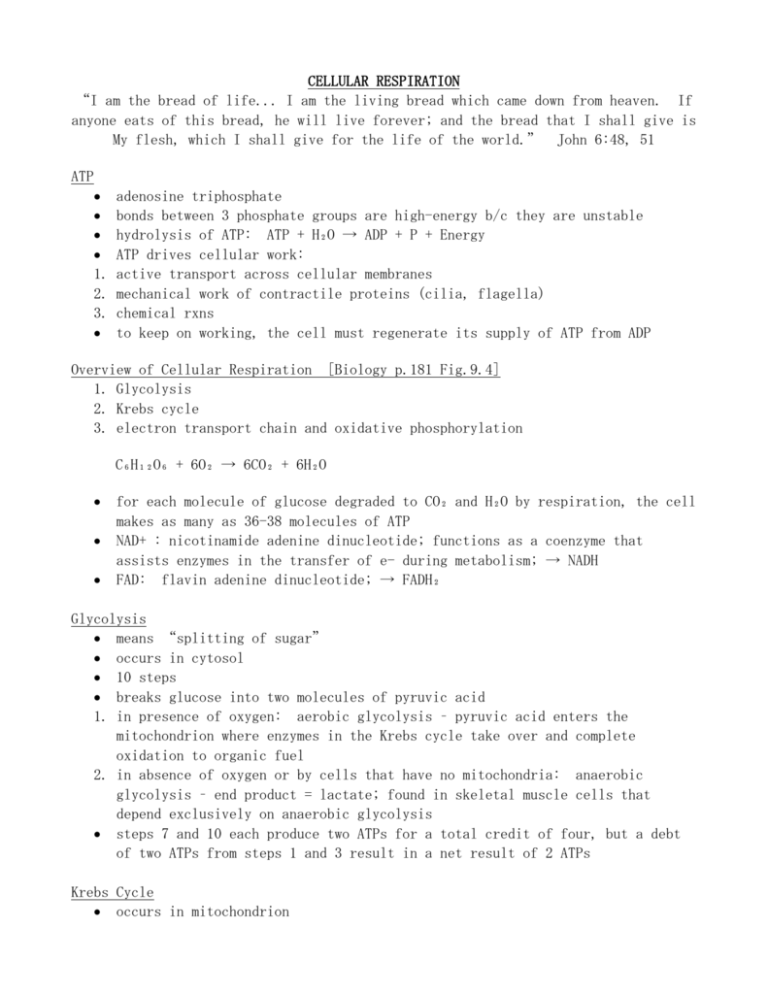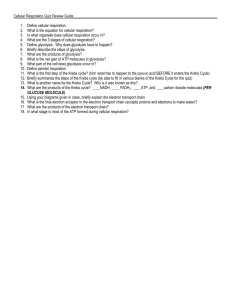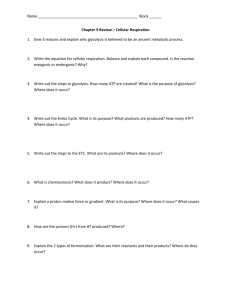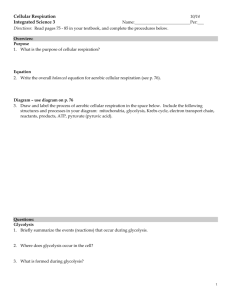File - Mrs. Riggs Online
advertisement

CELLULAR RESPIRATION “I am the bread of life... I am the living bread which came down from heaven. If anyone eats of this bread, he will live forever; and the bread that I shall give is My flesh, which I shall give for the life of the world.” John 6:48, 51 ATP 1. 2. 3. adenosine triphosphate bonds between 3 phosphate groups are high-energy b/c they are unstable hydrolysis of ATP: ATP + H₂O → ADP + P + Energy ATP drives cellular work: active transport across cellular membranes mechanical work of contractile proteins (cilia, flagella) chemical rxns to keep on working, the cell must regenerate its supply of ATP from ADP Overview of Cellular Respiration [Biology p.181 Fig.9.4] 1. Glycolysis 2. Krebs cycle 3. electron transport chain and oxidative phosphorylation C₆H₁₂O₆ + 6O₂ → 6CO₂ + 6H₂O for each molecule of glucose degraded to CO₂ and H₂O by respiration, the cell makes as many as 36-38 molecules of ATP NAD+ : nicotinamide adenine dinucleotide; functions as a coenzyme that assists enzymes in the transfer of e- during metabolism; → NADH FAD: flavin adenine dinucleotide; → FADH₂ Glycolysis means “splitting of sugar” occurs in cytosol 10 steps breaks glucose into two molecules of pyruvic acid 1. in presence of oxygen: aerobic glycolysis – pyruvic acid enters the mitochondrion where enzymes in the Krebs cycle take over and complete oxidation to organic fuel 2. in absence of oxygen or by cells that have no mitochondria: anaerobic glycolysis – end product = lactate; found in skeletal muscle cells that depend exclusively on anaerobic glycolysis steps 7 and 10 each produce two ATPs for a total credit of four, but a debt of two ATPs from steps 1 and 3 result in a net result of 2 ATPs Krebs Cycle occurs in mitochondrion step that forms acetyl CoA from pyruvic acid is junction between glycolysis and Krebs cycle: pyruvic acid breaks off carboxyl group (COOH) and attach remaining two-carbon fragment to a coenzyme [Biology p.188 Fig.9.10] cycle has eight steps, each catalyzed by a specific enzyme in the mitochondrial matrix for every turn of the cycle, two molecules of CO₂ and one ATP are generated because each glucose molecule was split in two during glycolysis, it takes two turns of the Krebs cycle to complete the oxidation of each glucose molecule that entered the cell as fuel resulting in total of 2 ATP Electron Transport Chain and Oxidative Phosphorylation inner membrane of mitochondrion/cristae; more surface area to produce ATP requires oxygen overall function is to transform the energy of e- of glucose into energy stored in phosphate bonds of ATP e- transport chain has several types of cytochromes proteins; the last cytochrome of the chain (cytochrome a₃) passes its e- to oxygen, which also picks up a pair of hydrogen ions from the aqueous medium to form water Catabolism of Various Food Molecules carbohydrates, fats, and proteins can all be used as fuel for respiration monomers of these food molecules enter glycolysis or the Krebs cycle at various points [Biology p.199 Fig.9.21] Activity Observing Cellular Respiration – the Krebs Cycle Coke = 26g sugar/cup sugar water = 12.6g sugar/cup chocolate milk = 33g sugar/cup pure apple juice = 40g sugar/cup Homework cellular respiration worksheet (posted online)








